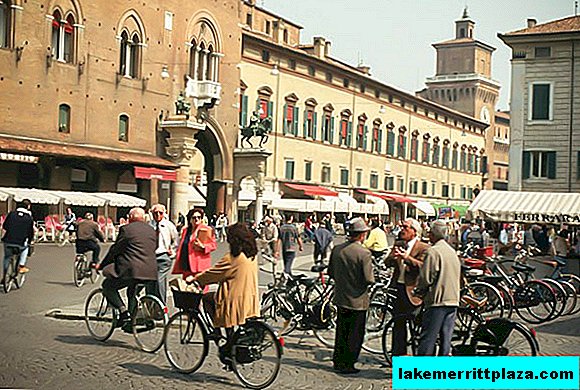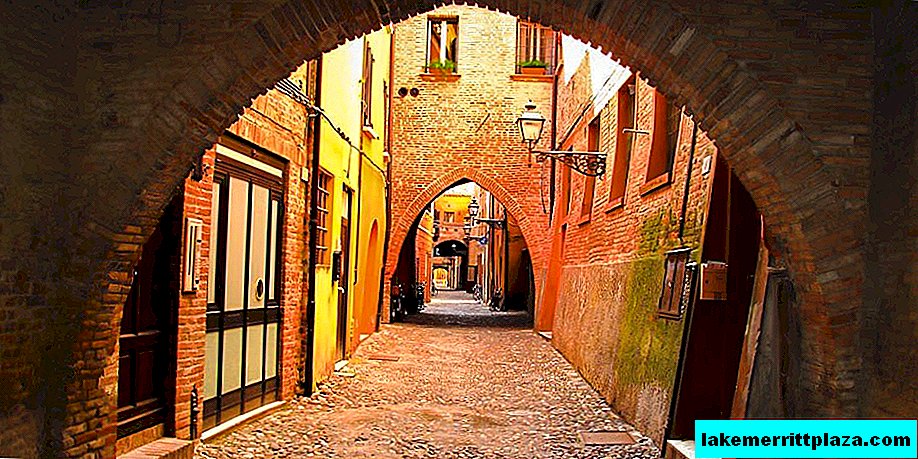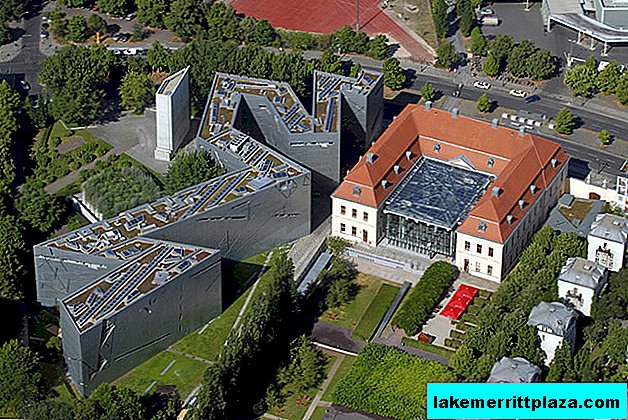1-2 days are enough to get acquainted with the sights of Ferrara, all of them are compactly located in the historical center (Centro Storico). Tourists, as a rule, prefer to inspect masterpieces of architecture leisurely walking along cozy streets and squares, paved with ancient paving stones.
You can also enjoy cycling around the city. The rental price is very affordable, and some hotels offer guests to use the popular local transport for free.
Ferrara is called the "city of bicycles" ("Citta delle biciclette"), which is not surprising, there are many specially equipped tracks, and in the center there are practically no cars and motorbikes. There are no fewer bicycles here than in Amsterdam, and the culture of movement on two wheels originated in Ferrara in the middle of the 20th century.

The ancient city is of great historical and cultural value; it was not without reason that it was recognized in 1995 as part of the World Heritage, and taken under the protection of UNESCO.
The modern look of Ferrara was formed in the late XV and early XVI centuries, thanks to the work of the architect Biagio Rossetti, attracted by the Duke Ercole I d'Este.
The master was tasked with increasing the urban space, taking into account the humanistic ideals in architecture, the needs of residents and local traditions. As a result, Ferrara has become a model of urban planning, ideally combining proportion, symmetry of forms and respect for historical heritage. The strict Roman geometry of the new wide avenues organically interwoven into the labyrinths of narrow medieval streets.
What are the main attractions to see a tourist in Ferrara in one day?
Street Corso Ercole d'Este
Corso Ercole d'Este (Corso Ercole I d'Este) is recognized as one of the most picturesque in the world. Design was carried out in the 90s of the XV century. During the Renaissance, it served as an important city artery, stretching from south to north, and connecting the Ducal Castle (Castello Estense) with the gates of the ancient fortress walls.

At the end of the street is a magnificent green massif formed by centuries-old trees. The Crossroads of Angels (Quadrivio degli Angeli) is one of the most interesting sites, decorated with the facades of ancient palaces, the architectural pearls of Ferrara. Corso Ercole d'Este Street is completely closed to road transport, there are almost no modern shops, which creates a feeling of immersion in the solemn atmosphere of the Renaissance era.
Via del Volte - Vault street
A walk along the narrow and quiet street of Via delle Volte, about 2 km long, as if by a time machine, takes guests of the city to the Middle Ages.

Ancient houses, standing on both sides close to each other, are connected by low arched vaults and passages. Thanks to this feature, the name of the street appeared. Buildings belonging to the XIII-XIV centuries belonged to local merchants, some served as brothels and gambling houses, later there was a Jewish ghetto.
Ferrara Cathedral
The Ferrara Cathedral of the Holy Martyr George (Basilica Cattedrale di San Giorgio Martire) is the main monument of church architecture in the city.

The temple building, originally erected in the spirit of Romanesque architecture, was consecrated at the dawn of the XII century. Over the next centuries, the temple was rebuilt several times, transforming its appearance.

The facade decor is a bizarre symbiosis of architectural styles, born of a change in historical eras. So, the lower part of the external walls, lined with white marble, was eventually supplemented by an elegant loggia with Gothic arches, niches and lancet windows. The bell tower, made in the classical Renaissance style, designed by the famous architect Leon Battista Alberti, dates back to the XV-XVI centuries.
The devastating fire of the XVII century irrevocably destroyed almost all the interior decoration of the cathedral. Only the fresco "The Last Judgment", written in the 70-80s of the 16th century by the famous artist Sebastiano Filippi, a vivid representative of the Ferrara school of painting, has survived.
The new interior was created in the style of sensual Italian Baroque. Molded vaults decorated with ornaments, ceiling and wall paintings, relief and sculptural compositions create a feeling of grandeur, monumentality and dynamics.

The Cathedral of St. George is located on the eponymous square Piazza della Cattedrale. He remains the current temple. Here solemn archbishop and papal services, ordinations in a dignity are held. Entrance is free, you can get inside daily from 7:30 to 18:30 (break - from 12:00 to 15:30). On Saturday and Sunday, the cathedral closes at 19:00.
The museum has a museum (Museo della Cattedrale), established in 1929. His collection includes exhibits telling about the history of Ferrara, items of church utensils, works of art from the palaces of the local nobility. Since 2002, the exposition has been housed in the premises of the former Church of St. Roman (Ex-Chiesa di San Romano), located opposite the cathedral, in the neighboring Piazza Trento e Trieste.

Museum doors are open to visitors all days of the week, except Mondays. Opening hours: 9:30 - 13:00 and 15:00 - 18:00. Entrance fee is 6 euros. For preferential categories of citizens there is a 50% discount.
Municipal Palace
Terrible and impregnable in appearance, the Palazzo Municipale, was erected in 1245, and served as the first residence of the influential d'Este clan.

Representatives of the ruling dynasty lived in the palace until the 16th century, later the city hall was located in the building (today the offices of the Ferrara City Hall are located here). Over the course of several centuries, the palazzo was rebuilt and expanded several times: significant changes were made under Niccolo II (Niccolo II d'Este), and during the reign of Ercole I (Ercole I d'Este), in the 80s of the XV century, the residence of the dukes acquired their current shapes and sizes. At the beginning of the 20th century, the facade overlooking Cathedral Square was redone in a neo-Gothic style. Some of the interior of the palace preserved the atmosphere of bygone times. Of particular interest are:
- "Golden Hall" (Stanza Dorata) with a decorative coffered ceiling, decorated with luxurious stucco molding and fragments of frescoes of the 15th century;
- "Tapestry Hall" with works by Flemish masters of the 17th century;
- The Duchess's Room (Stanzino delle Duchesse), decorated with painted wooden panels.

The luxurious interiors of the Palazzo Municipal can be seen on any weekday, admission is free. Excursions in Italian and English are held in accordance with the following schedule: on Monday, Wednesday and Friday - from 9:00 to 13:00, on Tuesday and Thursday - from 9:00 to 13:00 and from 15:00 to 17:00 .
Castle of the Dukes of d'Este
Surrounded by a moat with water, the majestic and somewhat heavy castle of the Dukes d'Este (Castello Estense) is the main and most recognizable symbol of Ferrara.

Its architectural complex includes four huge towers and a patio. The construction of Castello Estense dragged on for a long 200 years. The initial stage of work, which began in 1385, was led by the architect and engineer Bartolino da Novara, invited by Niccolo II d'Este. The master built three similar structures near the watch tower Lviv (Torre dei Leoni) built in the 13th century, connecting them with powerful walls. In the second half of the 15th century, a covered passage was made, combining the old residence of the dukes (Palazzo Municipal) with an impregnable castle designed to protect high-ranking persons from possible popular riots and rebellions. In the interior of Castello Estense, in addition to the ducal chambers, there were also:
- weapons workshops;
- blacksmiths;
- rooms for the garrison;
- underground cells of prisoners.
The Ferrarian court architect Girolamo da Carpi, who worked during the reign of Ercole II (Ercole II d'Este) and Alfonso II (Alfonso II d'Este), made a significant contribution to the transformation of the castle. Its current impressive appearance is the result of the master's engineering and creative ideas.
In 1999, Castello Estense conducted extensive restoration work. After 7 years, the interior of the castle was open to the public. The maximum cost of the admission ticket is 8 euros; discounts are applicable for children and organized tour groups. You can visit the attraction daily from 9:30 to 17:30 in the period from March to September, Monday is a day off in the remaining months. More information is available on the official website.
Palazzo Scifanoia
The construction of the Palazzo Schifanoia began in 1385 by order of Alberto V d'Este. The palace, located in a quiet place, once considered the distant outskirts of Ferrara, was supposed to serve as a country villa for lush banquets and other entertainment events. Hence the name of the palazzo, consonant with the phrase "schivar la noia", literally translated as "despise boredom."

The initial appearance of the palace was quite simple: it was a one-story building with a dull brick facade. Later, the area of the palazzo was enlarged, a marble portal with impressive sizes appeared with the family coat of arms of the city rulers flaunting at the top. In 1465, a second tier appeared under the Duke of Borso d'Este. A few years later, architect Pietro Benvenuti degli Ordini completed the interior decoration.
Of particular interest to art lovers is one of the rooms called the Hall of the Months (Salone dei Mesi), decorated with a series of frescoes of zodiac themes.

The mural was made by the best masters of the Ferrara school of painting. In 1493, the building underwent further and this time last changes, including the addition of another hall on the east side of the palace.
After the d'Este dynasty ceased to exist, the Palazzo Skifanoia more than once passed from one private hand to another. The lack of respect for the monument of architecture and painting led to significant damage: valuable frescoes were covered with a layer of plaster, the staircase overlooking the inner garden and the loggia were also affected. The mural, the greatest legacy of the Renaissance, was restored. At the end of the XIX century, the palace became the property of the municipality, and entered the complex of the City Museums of Ancient Art (Musei Civici di Arte Antica).
The attraction is located at Via Scandiana 23. The Palazzo is open to guests all days of the week, except Mondays, from 9:30 to 18:00. Ticket price - 3 euros.
Diamond palace
The Diamond Palace (Palazzo dei Diamanti), built in 1493-1503 according to the project of Biagio Rossetti, is recognized as a real masterpiece of Renaissance architecture.

When creating it, the features of perspective and the play of chiaroscuro were taken into account. The palazzo got its name due to the decoration of the facade, decorated with marble blocks, expertly cut in the form of precious stones. Like all similar constructions of Ferrara, the customer of the construction was representatives of the ducal clan d'Este.
In the 30s of the XIX century, the palace became the property of the city, today it houses the Gallery of Modern Art, as well as the National Pinacoteca Nazionale, which stores the works of masters of the XIV - XVIII centuries. For example, here are pictures of such famous painters as:
- Gentile de Fabriano (Gentile da Fabriano);
- Cosme Tura;
- Andrea Mantegna
- Vittore Carpaccio
The attraction is located at Corso Ercole I d'Este, 21. You can get inside the Diamond Palace on any day of the week, except Mondays, from 9:00 to 14:00, and on Thursday from 9:00 to 19:00. Entrance fee is 2 euros. Exhibitions of contemporary artists are paid separately.
Where to stay?
Map
For convenience, all the main attractions of Ferrara are mapped:








